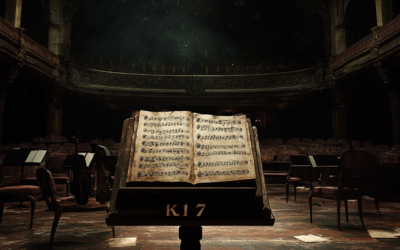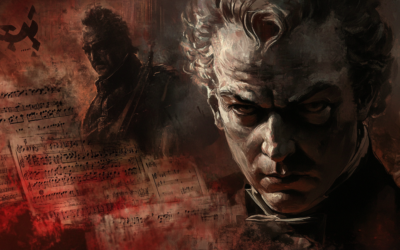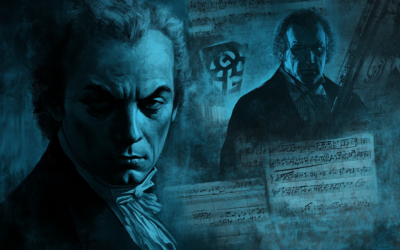Wolfgang Amadé Mozart
The Deceptive Nature of Mozart’s Catalogue
The Thematic Catalogue traditionally credited to Mozart is fraught with inaccuracies, suggesting that many of his famous works might not be his at all. This prompts a necessary reevaluation of Mozart’s legacy and the authenticity of his compositions.
“If Mozart had truly authored the Catalogue, he would not have mistakenly attributed the Arietta K. 541 to a bass when it was clearly intended for a tenor-baritone, casting further doubt on the document’s authenticity.”
Mozart: The Construction of a Genius
The Questionable Authenticity of K. 456
The legitimacy of Mozart’s Thematic Catalogue has long been debated, particularly regarding the inclusion of the Concerto K. 456 for Harpsichord and Orchestra, supposedly composed for the blind harpsichordist Teresa Paradis. The Catalogue indicates that the piece was completed on 30 September, just two days before Paradis’s final performance in Paris on 2 October. This timeline raises serious doubts. It seems highly unlikely that Mozart could have composed the Concerto, prepared all the necessary parts, and sent them to Paris in such a short span. The inclusion of this Concerto in the Catalogue without addressing these logistical challenges suggests a likely error or falsification in the dating.
Inconsistencies Surrounding K. 541
Further inconsistencies arise with the Arietta for Bass, K. 541, titled ‘Un bacio di mano’. The Catalogue lists this work as composed in May, yet it was later included in a Viennese revival of Pasquale Anfossi’s opera that same year. The Catalogue incorrectly attributes the performance to the famous bass Albertarelli, while in reality, it was sung by the tenor-baritone Del Sole. Such a mistake would be improbable if Mozart himself had recorded the information, casting further doubt on the Catalogue’s authenticity.
The Mystery of the Jupiter Symphony (K. 551)
The doubts surrounding Mozart’s Catalogue also extend to the famous Jupiter Symphony (K. 551). Some scholars point to similarities between this Symphony and the Arietta K. 541 to support Mozart’s authorship. However, if K. 541 was wrongly attributed to Mozart, the legitimacy of the Jupiter Symphony’s attribution is also questionable. Moreover, the original manuscript of the Symphony lacks Mozart’s signature or date, leading to speculation that the Catalogue was compiled posthumously to attribute this and other works to Mozart without solid evidence.
Discrepancies in Other Works
Questions also surround the authenticity of the Trio for Harpsichord, Violin, and Cello, K. 564, and the Masonic music, K. 477. Both works are listed in Mozart’s Catalogue, but with suspicious details that suggest someone else may have composed or copied them. The strikingly similar handwriting between the Catalogue and the manuscripts suggests potential forgery. Albert Osborn, a scholar on falsifications, argued that anyone who reproduces handwriting exactly is likely a forger, as it is impossible for a person to replicate the same phrase, musical passage, or signature identically multiple times.
Conclusion: A Catalogue of Errors
Often regarded as a definitive record of Mozart’s works, the Thematic Catalogue is fraught with inaccuracies, questionable attributions, and possible forgeries. These issues indicate that much of what has been traditionally accepted about Mozart’s later works, including some of his most celebrated compositions, may not be as it seems.
The discrepancies found in the Catalogue suggest it was likely created after Mozart’s death, potentially by those with an interest in enhancing his legacy. Given all these contradictions, the authenticity of many works attributed to Mozart must be reconsidered.
Journal of Forensic Document Examination
Mozart’s Catalogue Exposed
You May Also Like
Constanze Mozart’s Enduring Love
Although some have doubted her devotion, Constanze’s own words and actions illustrate a widow deeply committed to preserving Mozart’s legacy. Diaries, personal correspondence, and eyewitness testimony all challenge the notion that she neglected his memory—while the circumstances around his burial grow ever more perplexing.
A Revealing New Interview on His Thematic Catalogue
We’re excited to present a brand-new interview that challenges many of the long-held assumptions about Mozart’s Thematic Catalogue (1784–1791). Conducted by Swedish journalist Henry Grynnsten, this conversation delves into groundbreaking forensic techniques—like advanced ink analysis and digital image processing—that may change the way we view Mozart’s late works.
The Rattling Symphony: A Critical Take on K. 17
Often attributed to Mozart, the K. 17 symphony is anything but refined. Lacking orchestration and filled with gaps, it raises more questions than answers about its true authorship.
The Hidden Origins of the Salzburg Festival: A Nationalist Dream
The Salzburg Festival, far from being a mere celebration of Mozart’s genius, was born out of nationalist ambitions during a turbulent period in Austro-German history. Conceived by figures like Max Reinhardt, Heinrich Damisch, and Friedrich Gehmacher, the festival was deeply rooted in ultranationalistic ideals, transforming Mozart’s legacy into a tool for cultural dominance. The truth behind its founding has long been obscured, but the primary sources tell a different, darker story.
Mozart, Wagner, and the Nazi Myth
The Führer’s admiration for Wagner’s racially charged ideology not only influenced the policies of the Nazi regime but also reshaped the legacy of Mozart. Under National Socialism, Mozart was not celebrated as a universal genius but as a symbol of German purity and superiority. His music, stripped of its international influence, was rebranded as an expression of Aryan identity, intended to unify and inspire the German people.
Mozart, the Anschluss, and Nazi Propaganda
Following the 1938 Anschluss, the Nazi regime rebranded Mozart as the quintessential German composer, using his image to promote unity between Austria and Germany. The Salzburg Festival became a platform for Nazi propaganda, distorting Mozart’s legacy to fit their nationalistic and racial agenda.







